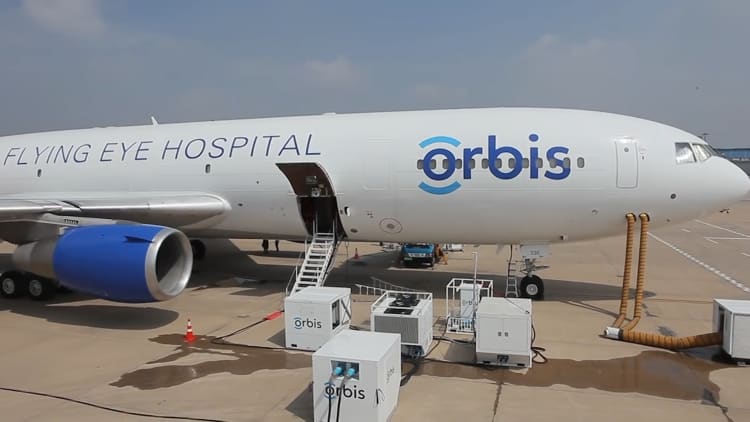Parked between an Emirates A380 and an Embraer Lineage 1000 at this year's Dubai Airshow was the world's only flying eye hospital.
The new Boeing MD-10 has been converted into a working hospital by charity Orbis International. It flies to developing countries to provide training for doctors and nurses, as well as delivering sight-saving surgeries.
The plane is made up of nine modular compartments.
There's the admin office, which has a hidden stairwell down into the converted cargo hold. No longer a place for luggage, it's now used by the plane's maintenance team.
Next it's the audio visual room that not only takes care of the on board Wi-Fi but monitors the many cameras inside the plane. These allow surgeries to be broadcast around the world, as well as streamed live to a 3-D TV for students sat in the classroom at the front of the plane.
Towards the back of the plane is the operating room kitted out with microscopes, scalpels and 3-D monitors. Right at the back of the plane is a large recovery room for patients.
The plane is also self-sustaining. They make their own hospital grade oxygen, burn their own jet fuel to power their equipment and have a water purifier that, according to Director of Aircraft Operations Bruce Johnson, is designed "to kill every bacteria known to man."
Johnson, an ex-U.S. Air Force pilot, showed me around Orbis' third generation hospital.
Its first generation plane was a DC-8, which took to the skies in 1982. Twelve years later the hospital moved into a DC-10, providing twice the space. In 2010 the charity was donated an MD-10 from FedEx. Six years later it was converted into the current Flying Eye Hospital. It can fly nearly twice as far as the DC-10, requires only two pilots — not three — and houses some of the most up-to-date ophthalmic training equipment in the world.
Before acquiring the new plane it made sure that the Federal Aviation Authority classified it as freight, ensuring that the hospital is considered separate to the aircraft. This saves 30 percent of their costs being spent on paperwork.
"On this airplane I can actually change this carpet and it doesn't have to have an aircraft certification because it's considered freight," says Johnson.
"For the lifetime of this airplane, any time I do anything back here I reduce the price of doing business."
Orbis International is a non-profit non-governmental organization (NGO) based out of the U.S. It focuses on the prevention and treatment of blindness in developing countries around the world.
The charity says that over the past five years it has trained over 10,000 doctors, conducted more than 12.5 million eye exams and performed around 350,000 eye surgeries.






